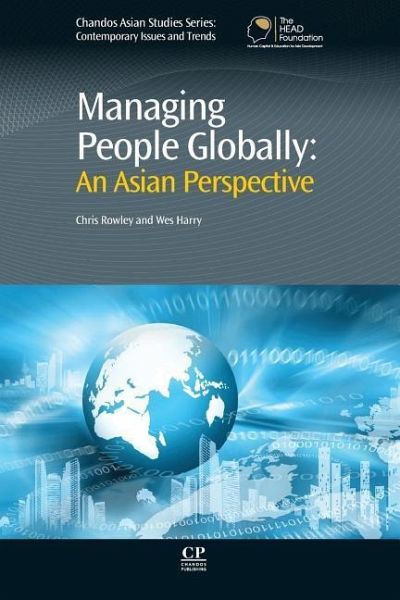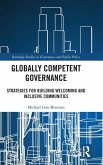- Broschiertes Buch
- Merkliste
- Auf die Merkliste
- Bewerten Bewerten
- Teilen
- Produkt teilen
- Produkterinnerung
- Produkterinnerung
This wide-ranging review of human resources management (HRM) in Asia draws attention to issues which are substantially different from those which a Western-trained manager or student would expect. Intra-regional issues are examined and, in an unusual approach, topics are organised thematically, rather than by the more typical country-by-country approach.
Andere Kunden interessierten sich auch für
![MANAGING PEOPLE GLOBALLY MANAGING PEOPLE GLOBALLY]() MANAGING PEOPLE GLOBALLY97,99 €
MANAGING PEOPLE GLOBALLY97,99 €![The Conflict in Syria and the Failure of International Law to Protect People Globally The Conflict in Syria and the Failure of International Law to Protect People Globally]() Jeremy Julian SarkinThe Conflict in Syria and the Failure of International Law to Protect People Globally46,99 €
Jeremy Julian SarkinThe Conflict in Syria and the Failure of International Law to Protect People Globally46,99 €![Ethical and Social Marketing in Asia Ethical and Social Marketing in Asia]() Bang NguyenEthical and Social Marketing in Asia86,99 €
Bang NguyenEthical and Social Marketing in Asia86,99 €![Globally Harmonized System of Classification and Labelling of Chemicals (Ghs) Globally Harmonized System of Classification and Labelling of Chemicals (Ghs)]() United Nations: Economic Commission for EuropeGlobally Harmonized System of Classification and Labelling of Chemicals (Ghs)133,99 €
United Nations: Economic Commission for EuropeGlobally Harmonized System of Classification and Labelling of Chemicals (Ghs)133,99 €![Rewarding Performance Globally Rewarding Performance Globally]() Fons Trompenaars (Netherland Trompenaars Hampden-Turner ConsultingRewarding Performance Globally61,99 €
Fons Trompenaars (Netherland Trompenaars Hampden-Turner ConsultingRewarding Performance Globally61,99 €![Globally Competent Governance Globally Competent Governance]() Michael Guo-BrennanGlobally Competent Governance152,99 €
Michael Guo-BrennanGlobally Competent Governance152,99 €![Yunnan-A Chinese Bridgehead to Asia Yunnan-A Chinese Bridgehead to Asia]() Tim SummersYunnan-A Chinese Bridgehead to Asia91,99 €
Tim SummersYunnan-A Chinese Bridgehead to Asia91,99 €-
-
-
This wide-ranging review of human resources management (HRM) in Asia draws attention to issues which are substantially different from those which a Western-trained manager or student would expect. Intra-regional issues are examined and, in an unusual approach, topics are organised thematically, rather than by the more typical country-by-country approach.
Produktdetails
- Produktdetails
- Chandos Asian Studies Series
- Verlag: Chandos Publishing / Elsevier Science & Technology
- Artikelnr. des Verlages: C2013-0-16620-2
- Englisch
- Abmessung: 22mm x 156mm x 234mm
- Gewicht: 796g
- ISBN-13: 9781843345237
- Artikelnr.: 45468986
- Herstellerkennzeichnung Die Herstellerinformationen sind derzeit nicht verfügbar.
- Chandos Asian Studies Series
- Verlag: Chandos Publishing / Elsevier Science & Technology
- Artikelnr. des Verlages: C2013-0-16620-2
- Englisch
- Abmessung: 22mm x 156mm x 234mm
- Gewicht: 796g
- ISBN-13: 9781843345237
- Artikelnr.: 45468986
- Herstellerkennzeichnung Die Herstellerinformationen sind derzeit nicht verfügbar.
Professor Chris Rowley has affiliations at IHCR, Korea University, Korea and IBAS, Griffith University, Australia as well as IAPS, Nottingham University, UK and Cass Business School, City University, London, UK and has been a Korea Foundation Research Fellow. He is Editor of the journals Asia Pacific Business Review and Journal of Chinese Human Resource Management and also Series Editor of the Working in Asia and Asian Studies book series. He has given a range of talks and lectures to universities and companies internationally, with research and consultancy experience with unions, business and government. He has published widely in the area of Human Resource Management and Asian business, with over 500 articles, books and chapters and practitioner pieces as well as being interviewed and quoted in a range of practitioner reports and magazines, radio and newspapers globally.
Dedication
List of figures and tables
Acknowledgements
Abbreviations
About the authors
Chapter 1: Introduction: HRM context, development and scope
1.1 Introduction
1.2 Chapter features and the wider relevance of HRM
1.3 What is HRM?
1.4 Rhetoric and reality in HRM
1.5 Tensions in HRM
1.6 A strategic role?
1.7 The context of HRM
1.8 Scope
1.9 Conclusion
Chapter 2: Employee resourcing
2.1 Introduction
2.2 Overview
2.3 HRP
2.4 Activities in HRP
2.5 Methods and data in HRP
2.6 Impacts on HRP
2.7 HRP in practice
2.8 Recruitment and selection
2.9 Stages
2.10 Sources and methods of recruitment and selection
2.11 Selection
2.12 Methods
2.13 Recruitment and selection in practice
2.14 Conclusion
Chapter 3: Employee rewards
3.1 Introduction
3.2 Overview
3.3 Rewards and integration
3.4 Types of reward
3.5 Determinants
3.6 Performance-related rewards
3.7 PRP schemes
3.8 Difficulties with PRP
3.9 Rewards in practice
3.10 Conclusion
Chapter 4: Employee development
4.1 Introduction
4.2 Overview
4.3 Training
4.4 Management development
4.5 Factors shaping provision and effectiveness
4.6 Determining and locating training
4.7 Evaluation
4.8 Training in practice
4.9 International comparisons in training
4.10 Variety in training provision
4.11 Performance appraisal
4.12 Methods and techniques
4.12.4 Ranking
4.13 Potential problems with performance appraisal
4.14 International comparisons in performance appraisal
4.15 Conclusion
Chapter 5: Employee relations
5.1 Introduction
5.2 Overview
5.3 Employee relations
5.4 Concept of a 'system'
5.5 Strategic choice
5.6 Frames of reference
5.7 Individualism versus collectivism
5.8 Partnership
5.9 The future of employee relations
5.10 Employee involvement
5.11 Forms of employee involvement
5.12 Conclusion
Chapter 6: Conclusion
6.1 Introduction
6.2 Key points
6.3 Comparisons
6.4 The future of HRM
6.5 Conclusion
Contemporary developments
Managing people â?" as seen in art and culture
Case studies
Index
List of figures and tables
Acknowledgements
Abbreviations
About the authors
Chapter 1: Introduction: HRM context, development and scope
1.1 Introduction
1.2 Chapter features and the wider relevance of HRM
1.3 What is HRM?
1.4 Rhetoric and reality in HRM
1.5 Tensions in HRM
1.6 A strategic role?
1.7 The context of HRM
1.8 Scope
1.9 Conclusion
Chapter 2: Employee resourcing
2.1 Introduction
2.2 Overview
2.3 HRP
2.4 Activities in HRP
2.5 Methods and data in HRP
2.6 Impacts on HRP
2.7 HRP in practice
2.8 Recruitment and selection
2.9 Stages
2.10 Sources and methods of recruitment and selection
2.11 Selection
2.12 Methods
2.13 Recruitment and selection in practice
2.14 Conclusion
Chapter 3: Employee rewards
3.1 Introduction
3.2 Overview
3.3 Rewards and integration
3.4 Types of reward
3.5 Determinants
3.6 Performance-related rewards
3.7 PRP schemes
3.8 Difficulties with PRP
3.9 Rewards in practice
3.10 Conclusion
Chapter 4: Employee development
4.1 Introduction
4.2 Overview
4.3 Training
4.4 Management development
4.5 Factors shaping provision and effectiveness
4.6 Determining and locating training
4.7 Evaluation
4.8 Training in practice
4.9 International comparisons in training
4.10 Variety in training provision
4.11 Performance appraisal
4.12 Methods and techniques
4.12.4 Ranking
4.13 Potential problems with performance appraisal
4.14 International comparisons in performance appraisal
4.15 Conclusion
Chapter 5: Employee relations
5.1 Introduction
5.2 Overview
5.3 Employee relations
5.4 Concept of a 'system'
5.5 Strategic choice
5.6 Frames of reference
5.7 Individualism versus collectivism
5.8 Partnership
5.9 The future of employee relations
5.10 Employee involvement
5.11 Forms of employee involvement
5.12 Conclusion
Chapter 6: Conclusion
6.1 Introduction
6.2 Key points
6.3 Comparisons
6.4 The future of HRM
6.5 Conclusion
Contemporary developments
Managing people â?" as seen in art and culture
Case studies
Index
Dedication
List of figures and tables
Acknowledgements
Abbreviations
About the authors
Chapter 1: Introduction: HRM context, development and scope
1.1 Introduction
1.2 Chapter features and the wider relevance of HRM
1.3 What is HRM?
1.4 Rhetoric and reality in HRM
1.5 Tensions in HRM
1.6 A strategic role?
1.7 The context of HRM
1.8 Scope
1.9 Conclusion
Chapter 2: Employee resourcing
2.1 Introduction
2.2 Overview
2.3 HRP
2.4 Activities in HRP
2.5 Methods and data in HRP
2.6 Impacts on HRP
2.7 HRP in practice
2.8 Recruitment and selection
2.9 Stages
2.10 Sources and methods of recruitment and selection
2.11 Selection
2.12 Methods
2.13 Recruitment and selection in practice
2.14 Conclusion
Chapter 3: Employee rewards
3.1 Introduction
3.2 Overview
3.3 Rewards and integration
3.4 Types of reward
3.5 Determinants
3.6 Performance-related rewards
3.7 PRP schemes
3.8 Difficulties with PRP
3.9 Rewards in practice
3.10 Conclusion
Chapter 4: Employee development
4.1 Introduction
4.2 Overview
4.3 Training
4.4 Management development
4.5 Factors shaping provision and effectiveness
4.6 Determining and locating training
4.7 Evaluation
4.8 Training in practice
4.9 International comparisons in training
4.10 Variety in training provision
4.11 Performance appraisal
4.12 Methods and techniques
4.12.4 Ranking
4.13 Potential problems with performance appraisal
4.14 International comparisons in performance appraisal
4.15 Conclusion
Chapter 5: Employee relations
5.1 Introduction
5.2 Overview
5.3 Employee relations
5.4 Concept of a 'system'
5.5 Strategic choice
5.6 Frames of reference
5.7 Individualism versus collectivism
5.8 Partnership
5.9 The future of employee relations
5.10 Employee involvement
5.11 Forms of employee involvement
5.12 Conclusion
Chapter 6: Conclusion
6.1 Introduction
6.2 Key points
6.3 Comparisons
6.4 The future of HRM
6.5 Conclusion
Contemporary developments
Managing people â?" as seen in art and culture
Case studies
Index
List of figures and tables
Acknowledgements
Abbreviations
About the authors
Chapter 1: Introduction: HRM context, development and scope
1.1 Introduction
1.2 Chapter features and the wider relevance of HRM
1.3 What is HRM?
1.4 Rhetoric and reality in HRM
1.5 Tensions in HRM
1.6 A strategic role?
1.7 The context of HRM
1.8 Scope
1.9 Conclusion
Chapter 2: Employee resourcing
2.1 Introduction
2.2 Overview
2.3 HRP
2.4 Activities in HRP
2.5 Methods and data in HRP
2.6 Impacts on HRP
2.7 HRP in practice
2.8 Recruitment and selection
2.9 Stages
2.10 Sources and methods of recruitment and selection
2.11 Selection
2.12 Methods
2.13 Recruitment and selection in practice
2.14 Conclusion
Chapter 3: Employee rewards
3.1 Introduction
3.2 Overview
3.3 Rewards and integration
3.4 Types of reward
3.5 Determinants
3.6 Performance-related rewards
3.7 PRP schemes
3.8 Difficulties with PRP
3.9 Rewards in practice
3.10 Conclusion
Chapter 4: Employee development
4.1 Introduction
4.2 Overview
4.3 Training
4.4 Management development
4.5 Factors shaping provision and effectiveness
4.6 Determining and locating training
4.7 Evaluation
4.8 Training in practice
4.9 International comparisons in training
4.10 Variety in training provision
4.11 Performance appraisal
4.12 Methods and techniques
4.12.4 Ranking
4.13 Potential problems with performance appraisal
4.14 International comparisons in performance appraisal
4.15 Conclusion
Chapter 5: Employee relations
5.1 Introduction
5.2 Overview
5.3 Employee relations
5.4 Concept of a 'system'
5.5 Strategic choice
5.6 Frames of reference
5.7 Individualism versus collectivism
5.8 Partnership
5.9 The future of employee relations
5.10 Employee involvement
5.11 Forms of employee involvement
5.12 Conclusion
Chapter 6: Conclusion
6.1 Introduction
6.2 Key points
6.3 Comparisons
6.4 The future of HRM
6.5 Conclusion
Contemporary developments
Managing people â?" as seen in art and culture
Case studies
Index








